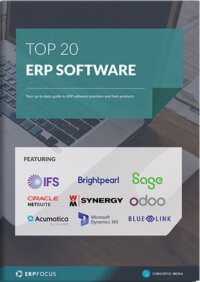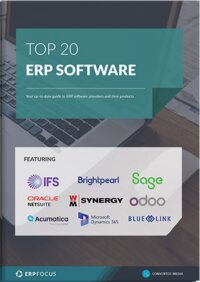The most common systems for ERP integration
It will seem strange to ERP purists to see a blog about ERP integration. ERP is, by definition, an integrated system, offering wall-to-wall functionality for all manner of companies and organizations. So, even though not all organizations will use all elements of these systems, to be an ERP system the software has to cover the following areas:
- Sales order processing; including the ability to handle returns for credit or for repair
- Materials management; including inventory control, purchasing, and warehouse management.
- Manufacturing; including materials requirements planning (MRP), capacity planning and scheduling, works order processing, work in progress (WIP) tracking, engineering change control, and costing.
- Finance; including general ledger, accounts payable, accounts receivable, cash book, and payroll
- Customer Relationship Management (CRM).
There are, however, several things to consider when using this definition. One is that there are niche systems that intentionally cover only some of the above functionality and whether or not such systems are truly ERP is a moot point although it could be said that, as long as they satisfy the needs of the organizations that buy and use them, the label that they are sold under may actually be irrelevant.
The second thing to consider is that many, though by no means all, ERP systems come from an accounting background (even though they are demonstrably not accounting systems). Particularly in the mid-market, some systems are effectively just finance systems with some rudimentary buy, assemble, stock, sell functionality added. For many organizations these 'faux ERP' systems can be quite adequate; especially as they are generally much cheaper than 'full functionality' systems.
But a distribution company that buys such a system will eventually, and inevitably, regret not having proper warehouse management functionality such as put-away instructions, optimized picking paths etc. And a manufacturing company will regret not having a lot of the functionality mentioned earlier; such as MRP, Capacity Scheduling etc.
Lastly; there are niche requirements that even the largest and most expensive ERP systems don't always have because the market is too small or too specialized. All that vendors and system integrators look to do is to identify software that satisfies such requirements and to integrate it into their offerings. These requirements mean links to:
- Third-party logistics (3PL) systems,
- Manufacturing execution systems,
- Point of sale (POS) systems,
- Time and attendance (T&A systems,
- Computer-aided design (CAD) systems.
Couriers and third-party logistics (3PL)
Increasingly, companies are recognizing that not only can't they be experts at everything - they don't have to be. One thing that is frequently sub-contracted is product deliveries. Rather than deliver product themselves, they contract specialist organizations to do so on their behalf because they realize that companies that specialize in an activity are usually more efficient at that activity and, even allowing for reasonable profit, are likely to be able to provide the service more economically than companies that are (rightly) focused on something else.
Data exchange between the two systems is relatively straight-forward, with the 3PL system needing delivery details and normally also shipment dimensions and weight, whilst the ERP system usually receives back a shipment tracking number. Companies need to decide, though, whether they want confirmation of actual customer delivery to be fed back into their ERP system and whether to invoice customers at the point of dispatch or to wait for that confirmation first: if delivery takes a few days, customers might not appreciate getting their invoice before getting their goods.
Manufacturing Execution Systems (MES)
Also known as shop floor control systems; whilst ERP is, by definition, a planning system, the primary function of MES is to collect production progress data and to transmit this, as close to real-time as possible, back to the ERP system (in fact, if this is all that they do, they are usually referred to as shop floor data capture (SFDC) systems). But, depending on the manufacturing environment, they may also be tasked with monitoring and recording resource usage (both time and materials) and quality data and feeding these back also.
Time and attendance systems
There can be an overlap between these and production management systems because T&A systems have come a long way from their origins. For many years they were simply a clock at the factory entrance where employees had their times of arrival and departure stamped on their own weekly 'time card' which, at the end of the week was taken to the payroll department.
The next step was to make the collection and transmittal of electronic data and that soon gave rise to new possibilities. Giving employees a card with a magnetic strip, and later an embedded chip, became an efficient way of limiting access to authorized areas and even to allowing their canteen expenses to be recorded and, if required, automatically deducted from their pay.
CAD data import
Computer Aided Design (CAD) systems hold information on the materials that go into a particular product: just the sort of information that the ERP system's bill of materials module needs. Clearly, there are advantages to transferring the data electronically but this is not always possible.
The problem is that some CAD systems can only produce a parts list (and, indeed that's all that some companies want). But if a product is made up of a number of sub-assemblies that are made separately and brought together for final assembly, a bill of level that supports this efficiently and effectively needs to recognize that structure. Some products can have a six or seven level bill and, if only a single-level bill (a parts list) is available, then MRP cannot do what it should be doing: automatically creating separate Works Orders for each assembly and sub-assembly, and time phasing the materials requirements for each of those.
An electronic transfer generally only works well when bills of material are single level; as can happen when products are manufactured in a continuous process such as on a production line. But, even then, the data from the CAD system usually has to be augmented because most ERP systems hold extra data such as alternative units of measure and scrap percentages.
Point-of-sale systems
Some manufacturers, in addition to processing sales orders from their customers, also have 'trade counters' or deports where customers (trade or retail) can visit. Whilst sales order processing functionality can be quite sophisticated within their main ERP system, frequently at this level something much more simple is sufficient; indeed preferable.
Many systems offer a simplified order entry routine that simultaneously creates a dispatch note and invoice, down-dates stock and perhaps even accepts payment, all in the same transaction (although this can then require further functionality to process credit and debit card transactions).
Final thoughts
It would be nice if all of the above functionality could be made available in standard ERP packages but, given that at least some of the options discussed, if added to mainstream ERP packages would only increase their sales by a very small amount, it would appear that, at least in the foreseeable future, the need to integrate to niche systems will remain and that the need to plan and design such links carefully will only increase in importance.
Free white paper

Top 20 ERP Software Comparison
Compare the top ERP systems using this guide

Related articles
-

Nine signs you need an eCommerce ERP integration
A guest blog from Brightpearl discussing eCommerce ERP and integration
-

CMMC Compliance: What Aerospace and Defense Manufacturers Need to Know
Key insights on CMMC compliance, deadlines, and securing DoD contracts with CMMC 2.0 certificatio...
-

Top 10 ERP selection criteria (including checklist)
The most important ERP selection criteria you should keep in mind during your selection process.

